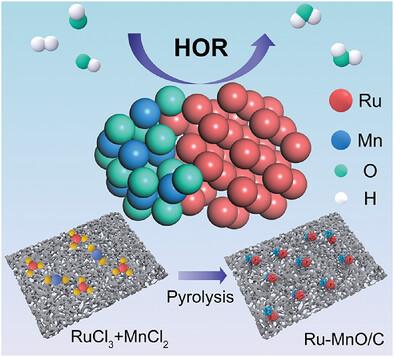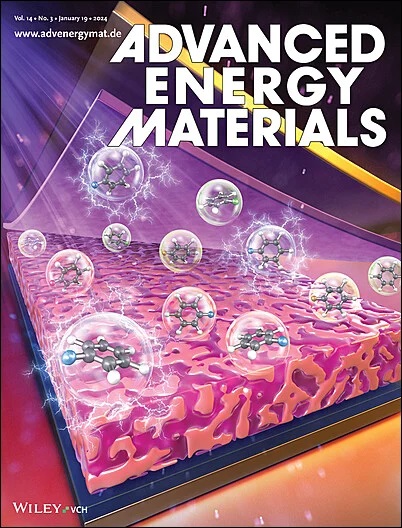Ru‐MnO Heterostructure Clusters Toward Efficient and CO‐Tolerant Alkaline Hydrogen Oxidation Reaction
IF 24.4
1区 材料科学
Q1 CHEMISTRY, PHYSICAL
引用次数: 0
Abstract
Designing efficient and CO‐tolerant catalysts for hydrogen oxidation reaction (HOR) in anode is one of the challenges for alkaline exchange membrane fuel cells in practical application. Herein, Ru‐MnO heterostructure with two adjacent clusters supported on commercial carbon (BP 2000) (denoted as Ru‐MnO/C) is designed to accelerate the sluggish kinetics of alkaline HOR. The cluster–cluster heterostructure interface modifies the electronic structure of Ru sites with electron transfer from Ru to MnO, then optimizes the adsorption of intermediates on Ru sites. Consequently, this catalyst exhibits high catalytic HOR activities in alkaline media with high exchange current density (3.71 mA cm

实现高效和耐一氧化碳碱性氢氧化反应的 Ru-MnO 异质结构团簇
设计高效且耐一氧化碳的阳极氢氧化反应催化剂是碱性交换膜燃料电池在实际应用中面临的挑战之一。在此,我们设计了在商用碳(BP 2000)上支撑两个相邻簇的 Ru-MnO 异质结构(称为 Ru-MnO/C),以加速碱性氢氧化反应的缓慢动力学。簇-簇异质结构界面通过从 Ru 到 MnO 的电子转移改变了 Ru 位点的电子结构,然后优化了中间产物在 Ru 位点上的吸附。因此,这种催化剂在碱性介质中表现出较高的催化 HOR 活性,具有较高的交换电流密度(3.71 mA cm-2)和质量活性(0.78 A mgRu-1)。同时,在 H2/O2 条件下,碱性交换膜燃料电池的比峰值功率密度(PPD)为 7.0 W mg-1Ru,高于大多数已报道的催化剂。更重要的是,该催化剂还具有显著的稳定性和耐 CO 性。这项工作展示了簇-簇异质结构界面在高效 HOR 方面的优越性,有望进一步启迪电催化先进催化剂的设计。
本文章由计算机程序翻译,如有差异,请以英文原文为准。
求助全文
约1分钟内获得全文
求助全文
来源期刊

Advanced Energy Materials
CHEMISTRY, PHYSICAL-ENERGY & FUELS
CiteScore
41.90
自引率
4.00%
发文量
889
审稿时长
1.4 months
期刊介绍:
Established in 2011, Advanced Energy Materials is an international, interdisciplinary, English-language journal that focuses on materials used in energy harvesting, conversion, and storage. It is regarded as a top-quality journal alongside Advanced Materials, Advanced Functional Materials, and Small.
With a 2022 Impact Factor of 27.8, Advanced Energy Materials is considered a prime source for the best energy-related research. The journal covers a wide range of topics in energy-related research, including organic and inorganic photovoltaics, batteries and supercapacitors, fuel cells, hydrogen generation and storage, thermoelectrics, water splitting and photocatalysis, solar fuels and thermosolar power, magnetocalorics, and piezoelectronics.
The readership of Advanced Energy Materials includes materials scientists, chemists, physicists, and engineers in both academia and industry. The journal is indexed in various databases and collections, such as Advanced Technologies & Aerospace Database, FIZ Karlsruhe, INSPEC (IET), Science Citation Index Expanded, Technology Collection, and Web of Science, among others.
 求助内容:
求助内容: 应助结果提醒方式:
应助结果提醒方式:


